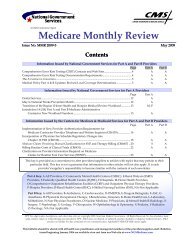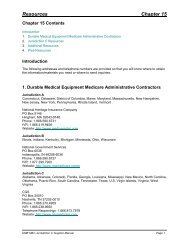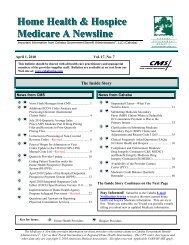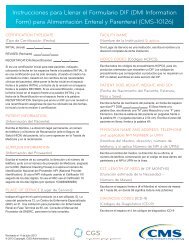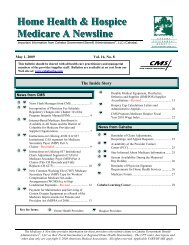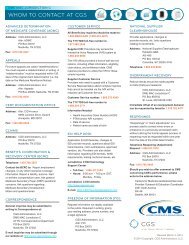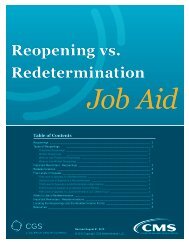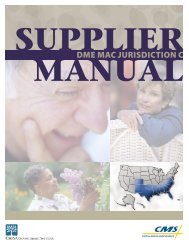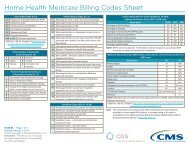Medicare Claim Review Programs: MR, NCCI Edits, MUEs, CERT ...
Medicare Claim Review Programs: MR, NCCI Edits, MUEs, CERT ...
Medicare Claim Review Programs: MR, NCCI Edits, MUEs, CERT ...
Create successful ePaper yourself
Turn your PDF publications into a flip-book with our unique Google optimized e-Paper software.
<strong>Medicare</strong><br />
<strong>Claim</strong> <strong>Review</strong> <strong>Programs</strong>:<br />
<strong>MR</strong>, <strong>NCCI</strong> <strong>Edits</strong>, <strong>MUEs</strong>, <strong>CERT</strong>, and RAC<br />
R<br />
Official CMS Information for<br />
<strong>Medicare</strong> Fee-For-Service Providers
Background<br />
Since 1996, the Centers for <strong>Medicare</strong> & Medicaid Services (CMS) has implemented several<br />
initiatives to prevent improper payments before a claim is processed and also, to identify and<br />
recoup improper payments after the claim is processed. The overall goal of CMS’ claim review<br />
programs is to reduce payment error by identifying and addressing billing errors concerning<br />
coverage and coding made by providers. The Improper <strong>Medicare</strong> Fee-For-Service Payments<br />
Report – November 2009, shows that 7.8 percent of the <strong>Medicare</strong> dollars paid did not comply with<br />
one or more <strong>Medicare</strong> coverage, coding, billing, or payment rules. This equates to $24.1 billion in<br />
<strong>Medicare</strong> overpayments and underpayments annually. This report can be reviewed at http://www.<br />
cms.gov/apps/er_report/edit_report_1.asp on the CMS website.<br />
CMS employs a variety of contractors to process claims submitted by physicians, hospitals, and<br />
other health care providers/suppliers and make payment to those providers in accordance with<br />
the <strong>Medicare</strong> rules and regulations. These organizations, called Carriers, Fiscal Intermediaries<br />
(FIs), and <strong>Medicare</strong> Administrative Contractors (MACs) 1 , are also referred to as <strong>Medicare</strong> claims<br />
processing contractors. CMS employs Program Safeguard Contractors (PSCs) 2 and Zone Program<br />
Integrity Contractors (ZPICs), which are responsible for identifying cases of suspected fraud and<br />
taking appropriate corrective actions. In addition, CMS employs Recovery Audit Contractors<br />
(RACs) to identify and correct underpayments and overpayments on a postpayment basis. The<br />
Comprehensive Error Rate Testing (<strong>CERT</strong>) contractor performs reviews on a small sample of<br />
<strong>Medicare</strong> Fee-For-Service (FFS) claims to produce an annual error rate.<br />
This booklet describes the following five claim review programs and their role in the life cycle<br />
of <strong>Medicare</strong> claims processing. The columns on the table below divide the programs based on<br />
performance of prepayment or postpayment reviews.<br />
Table 1. <strong>Medicare</strong> Prepayment and Postpayment <strong>Claim</strong> <strong>Review</strong> <strong>Programs</strong><br />
Prepayment <strong>Claim</strong> <strong>Review</strong> <strong>Programs</strong><br />
National Correct Coding Initiatives (<strong>NCCI</strong>)<br />
<strong>Edits</strong><br />
Medically Unlikely <strong>Edits</strong> (<strong>MUEs</strong>)<br />
Carrier/FI/MAC Medical <strong>Review</strong> (<strong>MR</strong>)<br />
Postpayment <strong>Claim</strong> <strong>Review</strong> <strong>Programs</strong><br />
Comprehensive Error Rate Testing (<strong>CERT</strong>)<br />
Program<br />
Recovery Audit Contractor (RAC)<br />
Carrier/FI/MAC Medical <strong>Review</strong> (<strong>MR</strong>)<br />
1<br />
<strong>Medicare</strong> Contracting Reform (MCR) Update – In Section 911 of the <strong>Medicare</strong> Prescription Drug,<br />
Improvement, and Modernization Act of 2003 (MMA) Congress mandated that the Secretary of the<br />
Department of Health and Human Services replace the current contracting authority under Title XVIII of<br />
the Social Security Act with the new <strong>Medicare</strong> Administrative Contractor (MAC) authority. This mandate<br />
is referred to as <strong>Medicare</strong> Contracting Reform. <strong>Medicare</strong> Contracting Reform is intended to improve<br />
<strong>Medicare</strong>’s administrative services to beneficiaries and health care providers. All <strong>Medicare</strong> work performed<br />
by Fiscal Intermediaries and Carriers will be replaced by the new A/B MACs by 2011. Providers may access<br />
the most current MCR information to determine the impact of these changes and to view the list of current<br />
MACs for each jurisdiction at http://www.cms.gov/<strong>Medicare</strong>ContractingReform on the CMS website.<br />
2<br />
Currently, Durable Medical Equipment (DME) PSCs perform medical review of DME claims. In the near<br />
future this function will be transferred to the DME MACs. The DME PSCs will be transitioned into ZPICs.<br />
2
The first two programs (<strong>NCCI</strong> <strong>Edits</strong> and <strong>MUEs</strong>) review claims before they are paid (called<br />
prepayment review). The second two programs (<strong>CERT</strong> and RAC) review claims after they are paid<br />
(called postpayment review). The <strong>MR</strong> program can perform both prepayment and postpayment<br />
reviews. A table at the end of this booklet summarizes the five programs and how they proactively<br />
identity potential billing errors concerning coverage and coding.<br />
National Correct Coding Initiatives (<strong>NCCI</strong>) <strong>Edits</strong><br />
Performed by: <strong>Medicare</strong> <strong>Claim</strong>s Processing Contractors<br />
CMS developed the <strong>NCCI</strong> to promote national correct coding methodologies and to control<br />
improper coding that leads to inappropriate payment in <strong>Medicare</strong> Part B claims. The coding<br />
policies are based on coding conventions defined in the American Medical Association’s (AMA’s)<br />
Current Procedural Terminology (CPT) Manual, Healthcare Common Procedure Coding System<br />
(HCPCS) Manual, national and local <strong>Medicare</strong> policies and edits, coding guidelines developed by<br />
national societies, standard medical and surgical practice, and/or current coding practice. <strong>NCCI</strong><br />
edits are updated quarterly.<br />
<strong>NCCI</strong> <strong>Edits</strong> Process<br />
The <strong>NCCI</strong> edits are automated prepayment edits. This means that as the submitted claim is<br />
processed by the <strong>Medicare</strong> claims processing contractor’s systems, the submitted procedures are<br />
analyzed to determine if they comply with the <strong>NCCI</strong> edit policy. Processing systems test every<br />
pair of codes reported for the same date of service for the same beneficiary by the same provider<br />
against the <strong>NCCI</strong> edit tables. If a pair of codes hits against an <strong>NCCI</strong> edit, the column two code of<br />
the edit pair is denied unless it is submitted with an <strong>NCCI</strong> associated modifier and the edit allows<br />
such modifiers.<br />
HCPCS/CPT codes representing services denied based on <strong>NCCI</strong> edits may not be billed to<br />
<strong>Medicare</strong> beneficiaries. Since these denials are based on incorrect coding rather than medical<br />
necessity, the provider cannot utilize an “Advanced Beneficiary Notice of Noncoverage” form to<br />
seek payment from a <strong>Medicare</strong> beneficiary. Furthermore, since the denials are based on incorrect<br />
coding rather than a legislated <strong>Medicare</strong> benefit exclusion, the provider cannot seek payment from<br />
the beneficiary with or without a “Notice of Exclusions from <strong>Medicare</strong> Benefits” form.<br />
Note: Outpatient Code Editor (OCE) edits differ from the <strong>NCCI</strong> edits. The OCE edits and the <strong>NCCI</strong><br />
edits are two editing systems used to process FI and Carrier-related claims, respectively.<br />
The <strong>NCCI</strong> edits are developed based on coding conventions defined in the AMA’s CPT<br />
Manual, current standards of medical and surgical coding practice, input from specialty<br />
societies, and based on analysis of current coding practice. The <strong>NCCI</strong> edits are used for<br />
Carrier processing of physician services under the <strong>Medicare</strong> Physician Fee Schedule (PFS)<br />
while the OCE edits are used by FIs for processing hospital outpatient services under the<br />
Hospital Outpatient Prospective Payment System (OPPS). The OCE is used in processing<br />
OPPS claims. A number of the <strong>NCCI</strong> edits are included in the OCE edits. The OCE edits<br />
are used exclusively under the hospital OPPS – they are not used within the <strong>Medicare</strong> PFS.<br />
3
Additional <strong>NCCI</strong> Resources<br />
<strong>NCCI</strong> <strong>Edits</strong> Overview Web Page (including <strong>NCCI</strong> FAQs)<br />
http://www.cms.gov/NationalCorrectCodInitEd<br />
<strong>Claim</strong>s Processing Manual Chapter 23 - Section 20.9<br />
http://www.cms.gov/manuals/downloads/clm104c23.pdf<br />
Providers/suppliers who have concerns regarding specific <strong>NCCI</strong> edits can submit comments in<br />
writing to:<br />
National Correct Coding Initiative<br />
Correct Coding Solutions LLC<br />
P.O. Box 907<br />
Carmel, IN 46082-0907<br />
Attention: Niles R. Rosen, M.D., Medical Director and Linda S. Dietz, RHIA, CCS, CCS-P,<br />
Coding Specialist<br />
Fax #: 317-571-1745<br />
The CCI <strong>Edits</strong> Manual may be obtained by purchasing the manual, or sections of the manual, from<br />
the National Technical Information Service (NTIS) website at http://www.ntis.gov/products/cci.<br />
aspx on the Internet, or by contacting NTIS at 1-800-363-2068 or 703-605-6060.<br />
Medically Unlikely <strong>Edits</strong> (<strong>MUEs</strong>)<br />
Performed by: <strong>Medicare</strong> <strong>Claim</strong>s Processing Contractors<br />
To lower the <strong>Medicare</strong> FFS paid claims error rate, CMS established units of service edits for<br />
<strong>Medicare</strong> Part B benefit claims, referred to as <strong>MUEs</strong>. Just like the <strong>NCCI</strong> edit, the MUE edit is an<br />
automated prepayment edit that helps prevent inappropriate payments. As the submitted claim is<br />
processed by the <strong>Medicare</strong> claims processing contractor’s systems, the submitted procedures are<br />
analyzed to determine if they comply with the MUE policy. An MUE for a HCPCS/CPT code is<br />
the maximum units of service under most circumstances that a provider would report for a code<br />
for a single beneficiary on a single date of service. <strong>MUEs</strong> are not meant to establish <strong>Medicare</strong><br />
payment policy, but rather to improve the accuracy of <strong>Medicare</strong> payments. <strong>MUEs</strong> do not exist for<br />
all HCPCS/CPT codes.<br />
CMS develops <strong>MUEs</strong> based on anatomic considerations, HCPCS/CPT code descriptors, CPT<br />
coding instructions, established CMS policies, nature of service/procedure, nature of an analyte,<br />
nature of equipment, and clinical judgment. All <strong>MUEs</strong> are validated against 100 percent claims<br />
data from a six-month period. Prior to implementation of <strong>MUEs</strong>, national health care organizations<br />
are offered an opportunity to review and comment about proposed edits. The <strong>MUEs</strong> do not require<br />
that <strong>Medicare</strong> contractors perform manual review or suspend claims. The <strong>MUEs</strong> only apply to the<br />
services specifically listed in the table of <strong>MUEs</strong>; thus all services will not have <strong>MUEs</strong> associated<br />
with them.<br />
In January 2007, CMS implemented the first <strong>MUEs</strong> for approximately 2,800 HCPCS/CPT codes<br />
based on anatomic considerations. On October 1, 2008, the majority of existing <strong>MUEs</strong> were made<br />
public and posted on the CMS website. CMS will not publish all MUE values because of fraud<br />
and abuse concerns.<br />
4
Providers should not interpret MUE values as utilization guidelines. MUE values do not represent<br />
units of service that may be reported without concern about medical review. Providers should<br />
continue to report only services that are medically reasonable and necessary.<br />
<strong>MUEs</strong> Process<br />
<strong>Claim</strong> lines that pass the MUE edits continue to be processed. Those claim lines that report units of<br />
service greater than the MUE value for the HCPCS code on the claim line are denied. A claim line<br />
denial due to an MUE may be appealed. Providers may request modification of an MUE value by<br />
contacting the <strong>NCCI</strong> contractor. See the answer to Question #8 in Table 2 (<strong>MUEs</strong> FAQs).<br />
Table 2. <strong>MUEs</strong> Frequently Asked Questions (FAQs)<br />
Question<br />
Answer<br />
1. What is the CMS The CMS MUE program was developed to reduce the paid claims error<br />
MUE program rate for <strong>Medicare</strong> claims. <strong>MUEs</strong> are designed to reduce errors due to<br />
clerical entries and incorrect coding based on anatomic considerations,<br />
HCPCS/CPT code descriptors, CPT coding instructions, established<br />
CMS policies, nature of a service/procedure, nature of an analyte,<br />
nature of equipment, and unlikely clinical treatment.<br />
2. What is an MUE An MUE is a unit of service (UOS) edit for a HCPCS/CPT code for<br />
services rendered by a single provider/supplier to a single beneficiary<br />
on the same date of service. The ideal MUE is the maximum UOS<br />
that would be reported for a HCPCS/CPT code on the vast majority of<br />
appropriately reported claims. The MUE program provides a method to<br />
report medically reasonable and necessary UOS in excess of an MUE.<br />
See answer to Question #4.<br />
3. How are claims<br />
adjudicated<br />
with <strong>MUEs</strong><br />
All CMS claims processing contractors adjudicate <strong>MUEs</strong> against each<br />
line of a claim rather than the entire claim. Thus, if a HCPCS/CPT code<br />
is reported on more than one line of a claim by using CPT modifiers,<br />
each line with that code is separately adjudicated against the MUE.<br />
Effective April 1, 2010, FIs and A/B MACs processing claims with<br />
the Fiscal Intermediary Shared System (FISS) deny the entire claim<br />
line if the units of service on the claim line exceed the MUE value for<br />
the HCPCS/CPT code on the claim line. Since claim lines are denied,<br />
the denial may be appealed. Prior to April 1, 2010 claims with units of<br />
service exceeding the MUE value for the HCPCS/CPT code on a claim<br />
line were returned to the provider. Since these claims were not denied,<br />
no appeal was applicable.<br />
(See answer to Question #4 for guidance on reporting medically<br />
reasonable and necessary services in excess of an MUE.)<br />
DMACs processing claims with the VMS system deny the entire claim<br />
line if the units of service on the claim line exceed the MUE for the<br />
HCPCS/CPT code on the claim line. Since claim lines are denied, the<br />
denial may be appealed.<br />
5
Question<br />
4. How do I report<br />
medically<br />
reasonable and<br />
necessary units of<br />
service in excess of<br />
an MUE<br />
5. Is there an appeal<br />
process for claim<br />
lines denied based<br />
on <strong>MUEs</strong><br />
6. How are claim<br />
lines adjudicated<br />
against an MUE<br />
for a repetitive<br />
service reported on<br />
a single claim line<br />
7. How were<br />
<strong>MUEs</strong> developed<br />
Answer<br />
Since each line of a claim is adjudicated separately against the<br />
MUE of the code on that line, the appropriate use of CPT modifiers<br />
to report the same code on separate lines of a claim will enable a<br />
provider/supplier to report medically reasonable and necessary units<br />
of service in excess of an MUE. CPT modifiers such as -76 (repeat<br />
procedure by same physician), -77 (repeat procedure by another<br />
physician), anatomic modifiers (e.g., RT, LT, F1, F2), -91 (repeat<br />
clinical diagnostic laboratory test), and -59 (distinct procedural service)<br />
will accomplish this purpose. Modifier -59 should be utilized only if no<br />
other modifier describes the service.<br />
Since claim lines are denied at Carriers and A/B MACs processing<br />
claims with the MCS system and at DMACs processing claims with<br />
the VMS system, MUE-based claim line denials at these contractors<br />
may be appealed.<br />
Effective April 1, 2010, FIs and A/B MACs processing claims with the<br />
FISS system deny claim lines with units of service exceeding the MUE<br />
value for the HCPCS/CPT code on the claim line. MUE based claim<br />
line denials may be appealed. Prior to April 1, 2010, claims processed<br />
by FISS were returned to the provider rather than denied, and no<br />
appeal process was applicable. Appeals should be submitted to local<br />
contractors, not the MUE contractor, Correct Coding Solutions, LLC.<br />
Some contractors allow providers to report repetitive services performed<br />
over a range of dates on a single line of a claim with multiple units of<br />
service. If a provider reports services in this fashion, the provider should<br />
report the “from date” and “to date” on the claim line. Contractors are<br />
instructed to divide the units of service reported on the claim line by the<br />
number of days in the date span and round to the nearest whole number.<br />
This number is compared to the MUE for the code on the claim line.<br />
<strong>MUEs</strong> were developed based on HCPCS/CPT code descriptors,<br />
CPT coding instructions, anatomic considerations, established CMS<br />
policies, nature of service/procedure, nature of an analyte, nature of<br />
equipment, and clinical judgment. All edits based on clinical judgment<br />
as well as many others were reviewed by workgroups of contractor<br />
medical directors.<br />
Prior to implementation of <strong>MUEs</strong>, the proposed edits were released for<br />
a review and comment period to the AMA, national medical/surgical<br />
societies, and other national health care organizations, including<br />
non-physician professional societies, hospital organizations, laboratory<br />
organizations, and durable medical equipment organizations.<br />
6
Question<br />
8. How do I request<br />
a change in the<br />
MUE value for a<br />
HCPCS/CPT code<br />
9. How do I make<br />
an inquiry about<br />
the MUE program<br />
other than about<br />
MUE levels for<br />
specific HCPCS/<br />
CPT codes<br />
10. Has CMS<br />
published the MUE<br />
levels for HCPCS/<br />
CPT codes<br />
11. Will CMS<br />
implement <strong>MUEs</strong><br />
for additional<br />
HCPCS/CPT<br />
codes<br />
Answer<br />
If a provider/supplier, health care organization, or other interested<br />
party believes that an MUE value should be modified, it may write<br />
Correct Coding Solutions, LLC at the address below. The party should<br />
include its rationale and any supporting documentation. However, it is<br />
commonly recommended that the party contact the national health care<br />
organization whose members perform the procedure prior to writing to<br />
Correct Coding Solutions, LLC. The national health care organization<br />
may be able to clarify the reporting of the code in question. If the<br />
national health care organization agrees that the MUE level should be<br />
modified, its support and assistance may be helpful in requesting the<br />
modification of an MUE level.<br />
Requests for modification of an MUE level should be sent to<br />
the following:<br />
National Correct Coding Initiative<br />
Correct Coding Solutions, LLC<br />
P.O. Box 907<br />
Carmel, IN 46082-0907<br />
FAX: 317-571-1745<br />
Some <strong>MUEs</strong> were modified in 2008 based on data refinement. The data<br />
refinement resulted in some MUE values being increased and others<br />
being decreased.<br />
Inquiries about the MUE program other than those related to MUE<br />
values for specific HCPCS/CPT codes should be sent to the following:<br />
Valeria Allen (valeria.allen@cms.hhs.com)<br />
CMS publishes most MUE values on its website. However, CMS does<br />
not publish MUE values for some codes. The MUE values for this<br />
latter group of codes are confidential information that should not be<br />
published by third parties who have acquired them.<br />
MUE values are not utilization guidelines. Providers may be subject<br />
to a review of their claims by claims processing contractors, PSCs, or<br />
RACs even if they report units of service less than or equal to the MUE<br />
value for a HCPCS code.<br />
CMS began implementation of <strong>MUEs</strong> for HCPCS/CPT codes on<br />
January 1, 2007. There are quarterly updates to the MUE files that<br />
include <strong>MUEs</strong> for additional codes. Although most HCPCS/CPT codes<br />
will have <strong>MUEs</strong>, some groups of codes have been temporarily excluded<br />
for future consideration.<br />
7
Additional MUE Resources<br />
CR 6712– Medically Unlikely <strong>Edits</strong> (<strong>MUEs</strong>)<br />
http://www.cms.gov/transmittals/downloads/R652OTN.pdf<br />
CCI <strong>Edits</strong>: Medically Unlikely <strong>Edits</strong> (<strong>MUEs</strong>)<br />
http://www.cms.gov/NationalCorrectCodInitEd/08_MUE.asp<br />
Quarterly Update to Medically Unlikely <strong>Edits</strong> (<strong>MUEs</strong>), Version 14, Effective January 1, 2008<br />
(CR 5824)<br />
http://www.cms.gov/transmittals/downloads/R1386CP.pdf<br />
Carrier/FI/MAC <strong>MR</strong> Program<br />
Performed by: <strong>Medicare</strong> <strong>Claim</strong>s Processing Contractors<br />
Through error rates produced by the <strong>CERT</strong> Program, vulnerabilities identified through the RAC<br />
Program, analysis of claims data, and evaluation of other information (e.g., complaints), suspected<br />
billing problems are identified by <strong>Medicare</strong> claims processing contractors. <strong>MR</strong> activities are<br />
targeted at identified problem areas appropriate for the severity of the problem.<br />
If the <strong>Medicare</strong> claims processing contractor verifies that an error exists through a review of a<br />
small sample of claims, the contractor classifies the severity of the problem as minor, moderate,<br />
or significant and imposes corrective actions that are appropriate for the severity of the infraction.<br />
The following types of corrective actions can result from <strong>MR</strong>:<br />
• Provider Notification/Feedback – Problems detected at minor, moderate, or significant levels<br />
will require the contractor to inform the provider of appropriate billing procedures.<br />
• Prepayment review – Prepayment review consists of <strong>MR</strong> of a claim prior to payment. Providers<br />
with identified problems submitting correct claims may be placed on prepayment review, in<br />
which a percentage of their claims are subjected to <strong>MR</strong> before payment can be authorized.<br />
Once providers have re-established the practice of billing correctly, they are removed from<br />
prepayment review.<br />
• Postpayment review – Postpayment review involves <strong>MR</strong> of a claim after payment has been made.<br />
Postpayment review is commonly performed by using Statistically Valid Sampling. Sampling<br />
allows an underpayment or overpayment (if one exists) to be estimated without requesting all<br />
records on all claims from providers. This reduces the administrative burden for <strong>Medicare</strong> and<br />
costs for both <strong>Medicare</strong> and providers.<br />
To help prevent improper payments, education for providers submitting claims is provided by the<br />
Provider Outreach and Education (POE) department.<br />
Both prepayment and postpayment reviews may require providers to submit medical records. When<br />
medical records are requested, the provider must submit them within the specified timeframe or the<br />
claim will be denied.<br />
Note: Effective August 1, 2008, Quality Improvement Organizations (QIOs) are no longer<br />
performing the <strong>MR</strong> for payment of acute inpatient prospective payment system hospital<br />
and long-term care hospital claims submitted after December 31, 2007. These reviews<br />
8
are the responsibility of the A/B MACs or FIs. QIOs will continue to perform providerrequested<br />
higher-weighted Diagnosis Related Group reviews.<br />
Additional Medical <strong>Review</strong> Resource<br />
<strong>Medicare</strong> Program Integrity Manual<br />
http://www.cms.gov/Manuals/IOM/list.asp<br />
Comprehensive Error Rate Testing (<strong>CERT</strong>) Program<br />
Performed by: <strong>CERT</strong> <strong>Review</strong> Contractor (<strong>CERT</strong> RC) and <strong>CERT</strong> Documentation<br />
Contractor (<strong>CERT</strong> DC)<br />
CMS uses the <strong>CERT</strong> Program to produce a national <strong>Medicare</strong> FFS error rate as required by the<br />
Improper Payments Elimination and Recovery Act. <strong>CERT</strong> randomly selects a small sample of<br />
<strong>Medicare</strong> FFS claims. <strong>CERT</strong> then reviews the claims and medical records from providers/suppliers<br />
who submitted them, and then reviews the claims for compliance with <strong>Medicare</strong> coverage, coding,<br />
and billing rules. In 2009, the <strong>CERT</strong> contractor randomly sampled 99,500 claims from <strong>Medicare</strong><br />
claims processing contractors during a one-year period. This process was designed to pull a blind<br />
sample of claims each day from all of the claims providers submitted that day.<br />
When performing these reviews, the <strong>CERT</strong> contractor follows <strong>Medicare</strong> regulations, billing<br />
instructions, National Coverage Determinations (NCDs), coverage provisions in interpretive<br />
manuals, and the respective <strong>Medicare</strong> claims processing contractor’s Local Coverage Determinations<br />
(LCDs). The <strong>CERT</strong> contractor does not develop or apply its own coverage, payment, or billing<br />
policies. To better gain insight into the causes of errors, CMS calculates not only a national<br />
<strong>Medicare</strong> FFS paid claims error rate but also service specific and provider type error rates and a<br />
provider compliance error rate. The results of the reviews are published in an annual report (and<br />
semi-annual updates).<br />
Paid <strong>Claim</strong>s Error Rate<br />
This rate is based on dollars paid after the <strong>Medicare</strong> contractor made its payment decision on<br />
the claim. This rate includes fully denied claims for FFS claims. The paid claims error rate is the<br />
percentage of total dollars that all <strong>Medicare</strong> FFS contractors erroneously paid or denied and is<br />
a good indicator of how claim errors in the <strong>Medicare</strong> FFS Program impact the trust fund. CMS<br />
calculates the gross rate by adding underpayments to overpayments and dividing that sum by total<br />
dollars paid.<br />
Provider Compliance Error Rate<br />
This rate is based on how the claims looked when they first arrived at the <strong>Medicare</strong> claims<br />
processing contractor before the contractor applied any edits or conducted any reviews. The<br />
provider compliance error rate is a good indicator of how well the contractor is educating the<br />
provider community since it measures how well providers prepared claims for submission.<br />
CMS does not collect covered charge data from provider facilities that submit claims to FIs or<br />
A/B MACs; therefore, current facility data is insufficient for calculating a provider compliance<br />
error rate.<br />
9
Other Error Rates<br />
The <strong>CERT</strong> report may also describe other error rates to provide the most specific information<br />
available to target problem areas. Other error rates include error rates by service type and by<br />
provider type. In addition, based on Executive Order 13520, Reducing Improper Payments and<br />
Eliminating Waste in Federal <strong>Programs</strong>, <strong>CERT</strong> has initiated four supplemental measures that will<br />
be reported annually, Power Mobility Devices (PMDs), Chiropractic Services, Pressure Reducing<br />
Support Surfaces, and Short Hospital Stays.<br />
<strong>CERT</strong> Process<br />
The <strong>CERT</strong> post-pay medical review process begins at the <strong>Medicare</strong> claims processing contractors.<br />
After the claims have been processed, samples of the claims are selected for <strong>CERT</strong> review. The<br />
<strong>CERT</strong> then uses information from the claims processing contractors to request documentation<br />
from the provider/supplier who submitted the sampled claim. The claim and the supporting<br />
documentation are reviewed by <strong>CERT</strong> Program clinicians who determine whether the claim was<br />
submitted and paid appropriately. The <strong>CERT</strong> Program collects additional information from the<br />
contractor for each claim considered to be in error via a feedback process.<br />
Due to the sampling methodology, a small percentage of providers would be subject to <strong>CERT</strong><br />
review. However, provider claims that are selected for <strong>CERT</strong> review are subject to potential<br />
post-pay payment denials, payment adjustments, or other administrative or legal actions depending<br />
upon the result of the review. <strong>Claim</strong>s can be adjusted or denied based on the <strong>CERT</strong> review and<br />
normal appeals rights and processes do apply.<br />
Additional <strong>CERT</strong> Resources<br />
<strong>CERT</strong> Overview Web Page<br />
http://www.cms.gov/<strong>CERT</strong>/01_overview.asp<br />
<strong>CERT</strong> Reports Web Page<br />
http://www.cms.gov/<strong>CERT</strong>/CR/list.asp<br />
Recovery Audit Contractor (RAC)<br />
Performed by: <strong>Medicare</strong> FFS RAC Contractors<br />
Section 306 of the <strong>Medicare</strong> Prescription Drug, Improvement, and Modernization Act of 2003<br />
(MMA) required CMS to complete a three-year demonstration program to determine whether<br />
the use of RACs is a cost-effective means of identifying and correcting <strong>Medicare</strong> overpayments<br />
and underpayments in the <strong>Medicare</strong> FFS Program. This demonstration program began in March<br />
2005 with jurisdictions in California, Florida, and New York because they are the largest states in<br />
terms of <strong>Medicare</strong> utilization. In the summer of 2007, the demonstration program was expanded to<br />
three more states to include Massachusetts, South Carolina, and Arizona. The RAC demonstration<br />
program ended in March 2008.<br />
In December 2006, the Tax Relief and Health Care Act of 2006 made the RAC Program permanent<br />
and authorized the expansion of the program nationwide by January 1, 2010. Contracts for all RAC<br />
10
egions were awarded in October 2008 but protests of the awards delayed actual execution of the<br />
contracts until February 2009. The latest information about the permanent RAC Program can be<br />
found at http://www.cms.gov/RAC on the CMS website.<br />
In March 2010, Congress again expanded the role of recovery audit contracting in the Affordable<br />
Care Act. Section 6411 of the Affordable Care Act expands the RAC Program to Medicaid and<br />
<strong>Medicare</strong> Parts C and D. This change requires all states to establish individual Medicaid RAC<br />
<strong>Programs</strong> under their State plan or waiver. In addition, the Affordable Care Act provision requires<br />
these RACs to also serve in a program integrity capacity, reviewing each <strong>Medicare</strong> Advantage and<br />
Part D plan’s anti-fraud plan.<br />
RAC Process<br />
Currently, the <strong>Medicare</strong> RACs are tasked with detecting and correcting improper payments on<br />
<strong>Medicare</strong> FFS claims (i.e., collecting overpayments and paying back underpayments). During FY<br />
2007, CMS gave each demonstration RAC all the claims for their jurisdiction that had been paid<br />
by <strong>Medicare</strong> claims processing contractors between October 1, 2002 and September 30, 2006.<br />
RACs apply statutes, regulations, CMS national coverage, payment, and billing policies, as well<br />
as LCDs that have been developed by the <strong>Medicare</strong> claim processing contractors. RACs do not<br />
develop or apply their own coverage, payment, or billing policies.<br />
In general, RACs will not review a claim that has previously been reviewed by another entity.<br />
RACs analyze claims data using their proprietary software, and identify claims that contain<br />
improper payments and those that likely contain improper payments. If a RAC finds an improper<br />
payment, the RAC sends a file to the claims processing contractor to adjust the claim and<br />
payment are recouped. In the case of claims that contain likely improper payments, the RAC<br />
requests the medical record from the provider, reviews the claim and medical record, and then<br />
makes a determination as to whether the claim contains an overpayment, an underpayment, or a<br />
correct payment.<br />
If a denial or adjustment is indicated by the review of records, providers will receive overpayment/<br />
underpayment notification letters. Providers can appeal denials (including no documentation<br />
denials) following the normal appeal processes by submitting documentation supporting<br />
their claims.<br />
Additional RAC Resources<br />
RAC Overview Web Page<br />
http://www.cms.gov/RAC/01_Overview.asp<br />
RAC Demonstration Web Page<br />
http://www.cms.gov/RAC/02_ExpansionStrategy.asp<br />
RAC Jurisdiction Contact Information<br />
http://www.cms.gov/RAC/Downloads/RAC%20contact%20information.pdf<br />
Recent Updates<br />
http://www.cms.gov/RAC/03_RecentUpdates.asp<br />
11
Table 3. Summary of <strong>MR</strong>, <strong>NCCI</strong> <strong>Edits</strong>, MUE, <strong>CERT</strong>, and RAC<br />
Providers<br />
Impacted<br />
<strong>Medicare</strong><br />
Contractor<br />
<strong>Claim</strong>s<br />
Impacted<br />
Prepayment<br />
Edit<br />
Postpayment<br />
Medical<br />
Record<br />
<strong>Review</strong><br />
<strong>NCCI</strong><br />
Providers<br />
who submit<br />
claims<br />
for Part B<br />
services<br />
using<br />
HCPCS/<br />
CPT codes<br />
<strong>NCCI</strong><br />
Contractor<br />
(develops<br />
the edits)<br />
<strong>Medicare</strong><br />
claims<br />
processing<br />
contractor<br />
operates<br />
the edits<br />
All Part B<br />
practitioner,<br />
ASC, and<br />
hospital<br />
OPPS<br />
claims<br />
screened<br />
Yes – tables<br />
updated<br />
quarterly<br />
MUE<br />
Providers/<br />
suppliers<br />
who submit<br />
claims<br />
for Part B<br />
services<br />
using<br />
HCPCS/<br />
CPT codes<br />
<strong>NCCI</strong><br />
Contractor<br />
(develops<br />
the edits)<br />
<strong>Medicare</strong><br />
claims<br />
processing<br />
contractor<br />
operates<br />
the edits<br />
All Part B<br />
practitioner,<br />
ASC,<br />
outpatient<br />
hospital<br />
and therapy<br />
claims<br />
screened<br />
Yes – tables<br />
updated<br />
quarterly<br />
Carrier/FI/<br />
MAC<br />
Medical <strong>Review</strong><br />
Providers<br />
who submit<br />
FFS claims<br />
Carriers<br />
Fiscal<br />
Intermediaries<br />
<strong>Medicare</strong><br />
Administrative<br />
Contractors<br />
Targeted claim<br />
review – number<br />
varies by<br />
Contractor’s<br />
Medical<br />
<strong>Review</strong> strategy<br />
<strong>CERT</strong><br />
Providers<br />
who submit<br />
FFS claims<br />
<strong>CERT</strong> <strong>Review</strong><br />
Contractor<br />
(<strong>CERT</strong> RC)<br />
<strong>CERT</strong><br />
Documentation<br />
Contractor<br />
(<strong>CERT</strong> DC)<br />
Limited<br />
random claim<br />
sample –<br />
historically<br />
Table 3. Summary of <strong>MR</strong>, <strong>NCCI</strong> <strong>Edits</strong>, MUE, <strong>CERT</strong>, and RAC (continued)<br />
Provider<br />
Response<br />
to Audit<br />
Request<br />
Right to<br />
Appeal<br />
<strong>NCCI</strong><br />
N/A<br />
Yes<br />
MUE<br />
N/A<br />
Yes<br />
Carrier/FI/<br />
MAC<br />
Medical <strong>Review</strong><br />
Providers must<br />
submit medical<br />
records to the<br />
Carrier/FI/MAC<br />
within 30 days<br />
from the receipt<br />
date of the<br />
initial letter<br />
Yes – using<br />
traditional<br />
appeals<br />
processes<br />
<strong>CERT</strong><br />
Providers must<br />
submit medical<br />
records to<br />
the <strong>CERT</strong><br />
DC within 30<br />
days from the<br />
receipt date of<br />
the initial letter<br />
Yes – using<br />
traditional<br />
appeals<br />
processes<br />
RAC<br />
Providers<br />
must submit<br />
medical<br />
records to<br />
the RAC (or<br />
request an<br />
extension)<br />
within 45<br />
days from the<br />
date of the<br />
initial letter<br />
requesting<br />
medical<br />
records<br />
Yes – using<br />
traditional<br />
appeals<br />
processes<br />
13
R<br />
Official CMS Information for<br />
<strong>Medicare</strong> Fee-For-Service Providers<br />
CPT only copyright 2009 American Medical Association. All rights reserved.<br />
CPT is a registered trademark of the American Medical Association.<br />
Applicable FARS\DFARS Restrictions Apply to Government Use.<br />
Fee schedules, relative value units, conversion factors and/or related components are not assigned<br />
by the AMA, are not part of CPT, and the AMA is not recommending their use. The AMA does<br />
not directly or indirectly practice medicine or dispense medical services. The AMA assumes no<br />
liability for data contained or not contained herein.<br />
This booklet was current at the time it was published or uploaded onto the web. <strong>Medicare</strong> policy<br />
changes frequently so links to the source documents have been provided within the document for<br />
your reference.<br />
This booklet is a general summary that explains certain aspects of the <strong>Medicare</strong> Program; however,<br />
this is not a legal document and does not grant rights or impose obligations. The Centers for<br />
<strong>Medicare</strong> & Medicaid Services (CMS) will not bear any responsibility or liability for the results or<br />
consequences of using this summary guide. This document was current as of the date of publication;<br />
nevertheless, we encourage readers to review the specific laws, regulations and rulings for<br />
up-to-date detailed information. Providers are responsible for the correct submission of claims<br />
and response to any remittance advice in accordance with current laws, regulations and standards.<br />
The <strong>Medicare</strong> Learning Network ® (MLN), a registered trademark of CMS, is the brand name for<br />
official CMS educational products and information for <strong>Medicare</strong> Fee-For-Service Providers. For<br />
additional information, visit the MLN’s web page at http://www.cms.gov/MLNGenInfo on the<br />
CMS website.<br />
October 2010<br />
ICN 006973<br />
14




